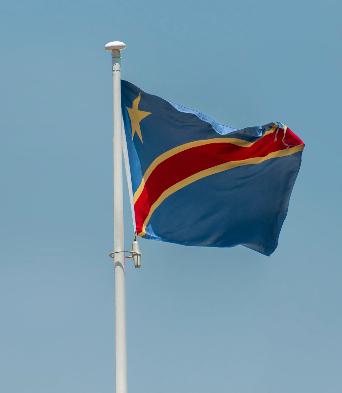“Variations on a Similar Theme: The Democratic Republic of Congo, Sub-Saharan African Culture, and the Beneficence of Cultural Integration!”
When my aunt was younger, she met the love of her life while volunteering abroad. She was on assignment with the Peace Corps in the Democratic Republic of Congo (then Zaire). The man whom she’d later marry sadly passed from cancer in 1987. This was exactly a month after his daughter was born and exactly a year before I was born. I would’ve liked to have met him. One, from what my family tells me, he was an interesting fellow. He was a jeweler, and so he must have been aesthetically minded. But also, it is- broadly speaking- fascinating to see how different cultures across the globe operate.
Many of my articles have been decidedly western-oriented. Lots about Shakespeare and Hollywood and cities like London, Paris, Rome, and Athens. I don’t say that shamefully. Western history/culture is very much a rich and fascinating field of knowledge. But ultimately, I want my analyses to cover the entire breadth of humanity. I dabbled a bit with one article on Machu Picchu and another on the Great Wall of China. Today, though, let’s take a journey to a place I have never actually ventured to. For my aunt, her venture brought about one of (if not the most) impactful experiences of her life. We’ll operate vicariously from that basis. Additionally, though, sub-Saharan Africa is where humanity cut its teeth, so let’s dive in!
The terrain is noteworthy. In the United States, we have dramatic settings like the Grand Canyon, Yosemite, and Niagara Falls. On the ground, though, things are relatively safe. If you go hiking in Appalachia or the Rockies, you run the risk of encountering wolves, mountain lions, and bears. But you are, for the most part, safe. Go into the brush of the D.R.C. and pitch your tent along the Congo River, though. You’ll quickly find out it isn’t the same thing.

“This isn’t the Adirondacks,” my aunt used to say (she and my dad’s side grew up in Upstate New York). She and a group of volunteers luckily survived one night, waking up and seeing large animal footprints outside their tent. Hippos, crocodiles, lions, hyenas, snakes…humans aren’t the top of the food chain out in the Congolese brush. They are yet just another item on nature’s expansive “Door-Dash menu.” There are plenty of “Heart of Darkness”-like stories entail explorers venturing into the wilderness and never re-emerging!
But let’s pull back from the brush for a moment and focus on the Democratic Republic of Congo itself. The founding of the Kongo had numerous precedents. Several former kingdoms- notably the Nsundi, Mpangu, Mbata, Inkisi, Wandu, Mpemba, Soyo and Mbamba- comprised it.3,4. From the 14th century onwards, the Kingdom of Kongo gave way to several kingdoms. These kingdoms included the Luba, Lunda, Kuba, Chokwe, and Yeke. Then arrived various periods of European colonization (namely, Belgian occupation). The Congo Crisis ensued between 1960 and 1965, and the modern nation emerged shortly thereafter.
Over 242 languages are spoken in the D.R.C. The nation is comprised of four main population groups. The Pygmies (hunter-gatherers and forest experts who’ve resided in the Congolese territory for thousands of years) is one. The Bantus (subsistence farmers who arrived in several waves between 2000 B.C.E. and 500 C.E.) is another. The others include the Swahili and various groups of northeastern cattle-herders (including the Tutsis).
Most people in the D.R.C. speak at least one of five different officially recognized languages. These languages are Kikongo ya leta, Lingala, Tshiluba, Kingwana, and French. Many Congolese are multilingual, and, like any group of people, shift up their language use depending on the context. For instance, a government official may formally use French. A citizen may use Lingala buying goods at a food market or their local language in their home village. People also do speak English (especially in the eastern part of the country). They incorporate slang spoken in Congo and Indubil.5
While at least 88% of the country practices Christianity, at least 10% adhere to traditional beliefs. Traditional beliefs espouse that a creator spirit (the “sovereign of the spirit world”) exists. It is not unlike the Christian God (according to some, it is omnipresent). But it’s also one that people can contact via ancestral spirits. Traditional religious adherents also believe in an essential life-force that animates the body. They believe in pantheistic natural spirits (that occupy whirlpools, lakes, springs, and mountains), diviners, witches, dream interpreters, and healers. They will often hold ceremonies and other collective prayers by sacred trees, grottoes, and crossroads.
The Congolese enjoy wild fruits, mushrooms, honey, and fish. Their diet further includes maize, rice, cassava, sweet potatoes, yams, taros, plantains, tomatoes, pumpkins, peas, and nuts. They export coffee beans and palm oil. “African Rumba,” or “Soukous” (a blend of South American and modern African musical styles) became popular in the pre-independence years.
The Yaka people used an eccentric raffia mask (“Ndeemba”) to initiate young men from childhood. They also used it to show women becoming part of the “sphere of men.”6 A performing, mask-wearing dancer may ridicule women and celebrate male virility.6,7 The Chokwe community used the Pwo-mask-oriented initiation ceremony to further engrain certain gender roles. The Kuba celebrated the role of women, though, by commissioning a Ngaady a Mwaash queen to highlighted women’s contributions to the royal court.8 Their ceremonies would demonstrate two men mock fighting one another for the queen’s affections. The Bwami society of the Lega people also integrated mask-wearing ceremonies into their culture.9 Some culture syncretized the art of Pablo Picasso and African American Harlem-Renaissance artists into their mask designs.10
The Kongo peoples believed that divine protection and sacred medicine came from the heavens above through “nkisis.” Nkisis were vessels that allegedly contained and released supernatural forces that could be used to settle disputes. The people could allegedly activate them by inserting a peg or nail into the vessel. The Luba people used “lukasas” (memory boards made from various sized beads of different materials) to convey mythological narratives. These narratives described the legends and history of the Luba kingdom/royal line.11
The D.R.C. derived its original name- Zaïre- from Portuguese. That in turn came from the Kikongo word Nzere/Nzadi (meaning “river that swallows all rivers”). A stalemate between the President and Parliament of the former Congo-Léopoldville colony in 1965 nearly destabilized the country.1 That was, however, until Joseph-Désiré Mobutu regained power.1 Mobutu, who dominated political life in Zaire, proclaimed himself “Father of the Nation.”1 Mobutu officially named the country the Republic of Zaire on October 27, 1971.2
Under Mobutu, citizens were obliged under the authenticité policy to adopt “authentic” names. Mobutu himself, for instance, dropped “Joseph-Désiré” and added “Sese Seko Kuku Ngbendu Wa Za Banga” (“all-conquering warrior who goes from triumph to triumph,” roughly) behind his previous surname.1
Mobutu’s political reconstruction/consolidation and adoption of a new constitution in 1974, though, eventually gave way to various internal contradictions. The repressive and brutal Bula Matari (“breaker of rocks”) rose to power.1 Mobutu did regain his power though and maintained it until 1997. Various violent and deadly conflicts punctuated that period, though.
The Angola-based Katangan rebels led two invasions (Shaba I and Shaba II) in 1977 and 1978 (respectively). The Safari Club and Western Bloc drove the rebels out. Post-Communist Katangan guerillas held Zairian, French, and Belgian miners hostage in May 1978. An airborne mission was required to rescue them. The end of the Cold War (late 1989/early 1990) also came with a series of domestic protests, alleged human rights violations, governmental corruption, and a faltering economy.
The First Congo War resulted from the country’s entanglement with the Hutus and Tutsis. The Tutsi militia (as well as various opposition groups that countries like Rwanda and Uganda supported), eventually ousted Mobutu. Laurent-Désiré Kabila, leader of the AFDL (Alliance des Forces Démocratiques pour la Libération du Congo-Zaïre) coalition marched unoppressed into Kinshasa (the nation’s capital city) on May 21, 1997. Mobutu and Kabila attempted peace talks. The talks failed, and so Mobutu fled into exile to Morocco on May 17, 1997. On May 21, 1997, Kabila renamed the country the “Democratic Republic of Congo.”
Warfare…internal strife…government corruption…suffering masses and the desperate ongoing measures to alleviate the suffering masses and steadily march towards something better. In other words, the story of every nation on earth! In one of my previous articles on Shakespeare’s “Othello,” I pointed out why racism and xenophobia are particularly toxic. It isn’t merely that they are predicated on hatred and disgust (although that is certainly one of the reasons). More significantly, though, racism and xenophobia cloud our collective vision. Humanity follows a certain path…a path that, many times, is excruciating and difficult. For that reason, fracturing this already rocky road into a million cumbersome pathways only further exacerbates the conditions of human life.
Being a stoic, protecting & providing warrior-hunter, silently-suffering matriarch, or some other universal archetype is difficult. It requires one to exhaust one’s body and spirit. Therefore, it is then worth living as one in a universal and singular manner. That established, it still is a delightful and awe-inspiring element of both travel and life to embrace the topical differences. I’m no moral or legal relativist. If slavery, murder, or executing someone for stealing a loaf of bread in one country is reprehensible, then it should be that way in every country. Dr. Martin Luther King Jr. had a famous quote that illustrates this philosophy: “An injustice anywhere is an injustice everywhere.”
But ethics and legalities aside, that which we can shift around a bit without upsetting the whole “sapiens” apple-cart—that is, the diversity of human culture– adds flavor to life. Some traditions are starkly different. The “okay sign” or “come here” gesture (curling one’s index finger inward) in the United States is fine, but someone might beat you up elsewhere if you flash either gesture. Sitting with the soles of your shoes facing outwards is fine in America, but very disrespectful in the Middle East.

Overall, though, that which many negatively label “cultural appropriation” (at least when rendered faithfully) is a wonderful thing! Mixing foods, musical traditions, habiliments, architecture, languages and more makes the world a very interesting place. My aunt used to work for the World Bank. She is a very lively, interesting, and open person, and one who undoubtedly lives by the principle that the global human condition is one of “variations on a similar theme!”
SOURCES
[1] Meditz, Sandra W.; Merrill, Tim, eds. (1994). Zaire: a country study (4th ed.). Washington, D.C.: Federal Research Division, Library of Congress.
[2] Kisangani, Emizet Francois; Bobb, Scott F. (2009). Historical Dictionary of the Democratic Republic of the Congo. Historical Dictionaries of Africa. Vol. 112 (3, illustrated ed.). Scarecrow Press. pp. li, 102.
[3] Unknown (prob Carmelite Missionary (1586). “Relacion del Regno de Congo”. Biblioteca Nazionale Centrale de Firenze, MS Pancitichiani 200. p. fol 163-163v.
[4] “Untitled Description of Congo”. Biblioteca Nazionale Centrale da Firenze Panc 200.
[5] “Ghetto Blaster : Et la rumba congolaise rythma les indépendances”. Retrieved 20 February 2011.
[6] “Headdress (Ndeemba): Yaka peoples”. The Metropolitan Museum of Art. Retrieved 10 October 2023.
[7] “Mask: Female (Pwo): Chokwe peoples”. The Metropolitan Museum of Art. Retrieved 10 October 2023.
[8] “Ngaady a Mwaash Mask”. Peabody Museum. Retrieved 10 October 2023.
[9] “Major Exhibition of African Sculpture by the Lega Peoples of the Democratic Republic of Congo at UMMA Oct 16-Jan 1”. University of Michigan Museum of Art. Retrieved 10 October 2023.
[10] Ryan, Bailey (17 April 2023). “How Much Did African Masks Influence Modern Art?”. The Collector. Retrieved 10 October 2023.
[11] Moss, Juliet. “Lukasa (memory board) (Luba peoples) (article)”. Khan Academy. Retrieved 10 October 2023.



